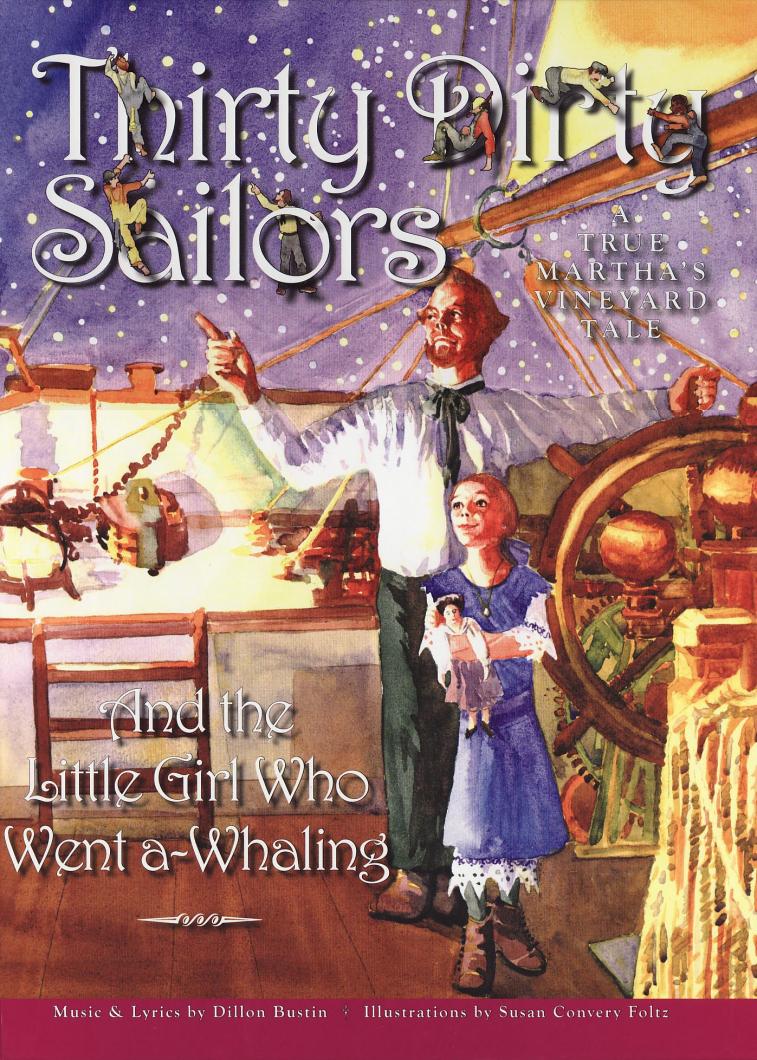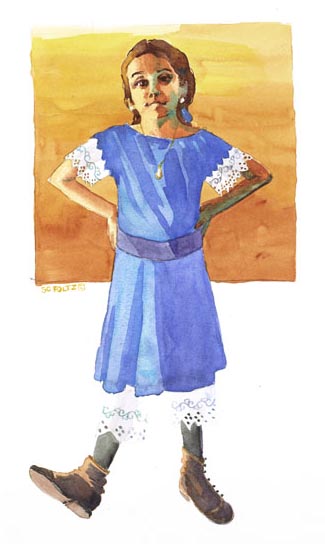Sixteen years ago, artist Susan Convery Foltz went out for something rare in Edgartown, an evening at the opera. As she settled into her pew in the Old Whaling Church, Ms. Convery Foltz had no idea that what she was about to hear, a collection of Vineyard histories set to music, would change her life and fulfill one of her lifelong dreams — to illustrate a children’s book.
Nearly two decades after she first heard the story of six-year-old Laura Jernegan, an Edgartown girl who traveled aboard her father’s whaling ship, Ms. Convery Foltz is celebrating the publication of her first children’s book, Thirty Dirty Sailors.
Dillon Bustin wrote the opera Ms. Convery Foltz attended. A few years before the premiere performance, he was visiting the Island when a storm hit, knocking out power for days. Rather than panic, Mr. Bustin boned up on his Vineyard history. Eventually he ventured down to the Martha’s Vineyard Museum, and it was there that he first saw a portrait of young Ms. Jernegan and began to learn her story.
Few whaling captains took their families along as they ventured out to sea to make a living. Jared Jernegan of Edgartown was an exception. In 1868, Captain Jernegan and his wife, Helen, gave their daughter Laura a choice: stay on Island with relatives and start public school while they went off to sea, or join them aboard the 125-foot ship, Roman. Ms. Jernegan chose the sea.
So as not to have her daughter fall behind in school, Mrs. Jernegan taught Laura her lessons every day and gave her a small leatherbound diary. Her entries begin on December 1, 1868. “It is Sunday and a very pleasant day,” it reads in capital letters. “I have read two story books. This is my journal. Good bye for to day.”
While digging through the museum archives, Mr. Bustin came across letters between Ms. Jernegan and her mother written many years after the voyage in which they reminisce about their trip, souvenirs and the diary itself. The diary, which Ms. Jernegan kept for three years until age nine, details the five months Ms. Jernegan spent at sea with her family, 30 sailors and a slew of animals. She continues to write after her father left his family in Hawaii while he continued to whale, and during her return voyage to the Vineyard, by train, from San Francisco. In it, she lists the food she ate (corn and beans), the route the ship took (“Monday 4th, January 1869. We past Cape Horn to day. It is a large black rock. Some of the rocks look like a steeple of a church.”) and the daily catch (“Monday 20th 1871. It is quite pleasant to day. We saw whales this morning, we lowered the boats and we got six, the men are cutting them now.”) Some months pass with no account. As time goes on, her entries grow longer and her writing transforms from block letters to cursive. A few sketches accompany the writing and the journal ends with three pages of Ms. Jernegan perfecting her signature.
The diary provides the rare view into life aboard a whaling ship and an even rarer glimpse at that life from a child’s perspective. “It is the only, or one of the few, journals of a child on a whaling ship,” said Nancy Cole, education project manager at the museum.
As Mr. Bustin researched Vineyard history at the museum, Ms. Jernegan’s decision — whether to join her family on the high seas or stay behind — continued to fascinate him. He decided to incorporate her story into his opera-in-progress, later titled Tidebook: An Island Rhapsody. “The song was written to try to capture that moment of decision,” he said.
Ms. Convery Foltz attended the debut performance of Mr. Bustin’s work in 1991. “The story hit me on so many levels,” she remembered recently from her home in Florida. Although no longer a New England resident, her ties to the Vineyard — and to the history of whaling — run deep. Her father was a collector of whaling memorabilia, and she was raised in the home where Nathan Jernegan, Ms. Jernegan’s uncle, once lived.
After watching the performance, Ms. Convery Foltz called Mr. Bustin. Over coffee at the Black Dog, she asked him if she could turn his song about Ms. Jernegan, Thirty Dirty Sailors, into a children’s story.
To begin, Ms. Convery Foltz went to the Martha’s Vineyard Museum and devoured all the stories and records she could. Next, she made trips to whaling museums — twice to Mystic, once to New Bedford and once to Nantucket — to collect antique photographs of whaling ships, whaling captains and whales. “The story in pictures is so much bigger than the story in words,” she said.
Along the way, Ms. Convery Foltz got married and had children. Last December, she contacted Jan Pogue and John Walter at Vineyard Voices, a publisher of nonfiction books about Martha’s Vineyard. They agreed to publish Ms. Jernegan’s story and Ms. Convery Foltz set to work painting 30 original pictures to accompany Mr. Bustin’s lyrics. “I tried to make it a progress of the voyage,” Ms. Convery Foltz said of the paintings.
Mrs. Cole of the museum thinks the pictures succeed. “She did a nice job of presenting the reality,” she said. “They are dirty sailors!”
Tomorrow, the book, which is accompanied by an audio recording of Mr. Bustin’s song and includes an introduction by Matthew Stackpole, executive director of the museum, makes its debut. To celebrate, Ms. Convery Foltz and Mr. Bustin are hosting a launch party at Featherstone Center for the Arts. The original artwork will be on display and for sale and Mr. Bustin will provide song. For Ms. Convery Foltz, it is the culmination of many years’ work and a dream fulfilled. “I have always been an artist and always wanted to illustrate a children’s book,” she said. “I was just looking for the right story.”
A kid-friendly book launch party for Thirty Dirty Sailors and the Little Girl Who Went a’Whaling is free from 3 to 5 p.m. at Featherstone Center for the Arts on Barnes Road in Oak Bluffs, with food, drink, music and autographs.






Comments
Comment policy »